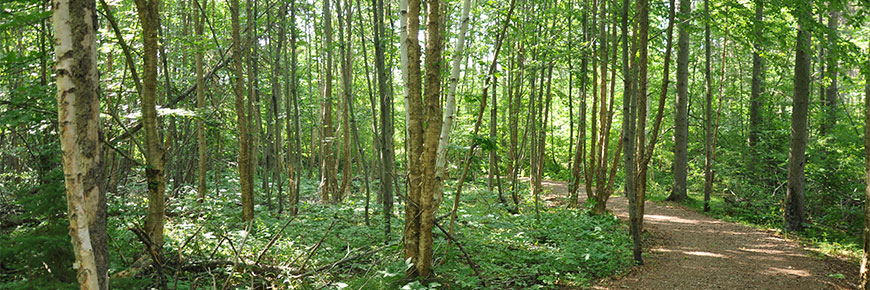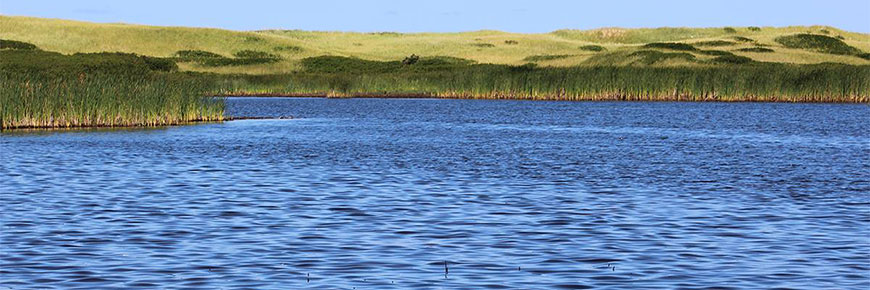
Environment
Prince Edward Island National Park
Ecosystems and habitats
Prince Edward Island National Park protects a portion of the Maritime Plain Natural Region, which is characterized by sand dunes, barrier islands and beaches, sandspits and associated wetlands. The diverse habitats in the park provide a home for a variety of plants and animals.
Four main ecosystems can be found in PEI National Park:
Coastal
Sand Dunes and Beaches
The sandbars, barrier beaches and dunes that you see throughout the park today were formed by the accumulation of sand from eroding sandstone.
Sand dunes are created by the wind and waves that carry dry sand up onto the beach where it collects behind rocks or clumps of seaweed. The gradual build-up of sand that forms a dune would be blown away if it were not for the sand-loving marram grass, whose roots and rhizomes form a living net which helps to slow the movement of sand. Once stabilized, a variety of other plants and many different animals can make the dunes their home.
Sand dunes are an important natural habitat and act as a natural protective barrier against the effect of storms and waves. Research on dunes and all its associated features - vegetation, wildlife and wetlands - helps us to understand and protect them better.
Marram grass
The roots and rhizomes of marram grass form a living net, which helps hold the dune in place. Research on the effect of trampling on vegetation is a major priority for the park.
Wild rose
Wild rose is one of the first shrubs to take root in more sheltered areas in the dunes. The shiny coating on its leaves protects it from the harsh environment.
Sand Dune Protection
Stable dunes provide shelter and food to wildlife and protect us from heavy storms.
Heavily vegetated dunes generally represent dunes that are more stable. Even the more stable dunes, however, are fragile and easily damaged. Walking on dunes eliminates the protective plant cover. Studies have shown that it can take as few as ten footsteps to destroy a marram grass colony. Once the grass is gone, the wind blows away the exposed sand and carves small depressions into giant holes called blowouts. Blowouts turn stable dunes into constantly shifting hills, unable to support vegetation or wildlife.
We need the cooperation of all visitors to preserve the dunes. Be aware that many of the dune systems in the park are protected under the National Parks General Regulations, and it is illegal to enter such areas. Please use the board walks and carpeted foot paths at designated beach access points and stay off the dunes to prevent further damage. By avoiding unauthorized paths, the marram grass will be able to thrive and regenerate, thus allowing damaged dunes to rehabilitate. Together, we can ensure that the fragile beauty of the dunelands will endure for future generations.
For more information, please visit: Visitor guidelines
Sandstone Cliffs
In some areas, the park coastline is made up mainly of red sandstone cliffs. These cliffs were formed from sand, silt and mud that was eroded from an ancient mountain range and deposited into a wide valley about 285 million years ago. Over time, these sediments were compressed into the layered sandstone bedrock of Prince Edward Island.
Their distinctive red colour comes from a mineral called hematite, which was produced when iron-rich minerals in the bedrock became oxidized or rusted. As the soft sandstone is easily eroded by the waves, the coastline is constantly changing.
Forest

The original forest found in this region is called the Acadian forest. This forest type is characterized by a mixture of hardwood and softwood species such as beech, sugar maple, yellow birch, hemlock, and red oak. By the 1900s, most of the finest forests were stripped and cleared for farming, fuel and lumber.
Later, white spruce, white birch and wild cherry began to take over abandoned farms and fields. Although a few pockets of the original Acadian forest remain, most of the forested area in the park is now made up mainly of white spruce and young regenerating forests.
For more information on conservation and restoration work in our PEI National Park forests, please visit: Conserving and restoring ecosystems.
Fresh water

Freshwater in streams and small, shallow freshwater lakes (known locally as ponds) occupies a small portion of the surface area (approximately 4%) of Prince Edward Island National Park.
The watersheds within Prince Edward Island National Park originate outside the national park boundary, and as a result, the park’s freshwater ecosystem is highly subject to land and water use outside the park. These watersheds are comprised of a series of spring-fed streams and/or shallow water, nutrient-rich ponds.
Eastern Brook Trout (Salvelinus fontinalis) are a common resident in most Atlantic Canada and PEI streams, and are species of special interest to Canadians. Many of the freshwater ponds in coastal areas provide habitat for fish, macro-invertebrates, and microbial and aquatic plant communities.
The American Eel (Anguilla rostrata) is widely distributed in freshwater, estuarine and protected coastal areas of eastern Canada including the barachois ponds of our park. This species is currently listed as threatened under the Committee on the Status of Endangered Wildlife in Canada (COSEWIC) and their distribution and abundance have been in decline in recent years. For more information, please visit: Protecting species.
Wetlands

Several small ponds are found behind the sand dunes throughout the park. Most of these are barachois or barrier ponds, which form when migrating sand dunes eventually close the mouth of a salt-water inlet or bay. No longer influenced by the ocean tides, the water gradually loses its salinity and becomes a freshwater pond. Ponds are important staging areas for water-fowl and provide habitat for many different species of plants and animals.
Salt marshes--low, grassy, muddy areas that are affected by saline waters and periodic flooding from tides-- border some of the sheltered shores of the park. A variety of plants have adapted to this special environment. As salt marshes provide important breeding areas for many birds and fish, they are among the most productive natural habitats in the world.
Management of our national parks must be based on a clear understanding of ecosystems and of all possible stresses on them. To ensure the continuity or sustainability of our park, we must view the natural environment as a whole, being careful to ensure that decisions take into consideration the interactions and dynamic nature of ecosystems as well as their capacity to withstand and recover from stress.
Together we can make a difference. To maintain the balance of nature, we must all be attentive to the impact we have on it. For more information on monitoring work in these ecosystems, please visit: Conserving and restoring ecosystems.
Related links
- Date modified :
